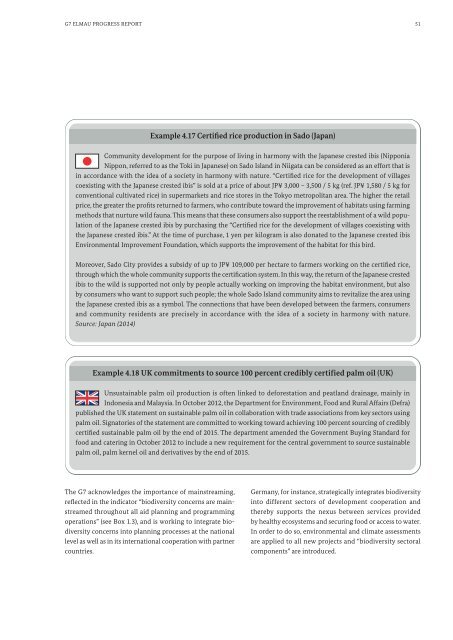G7-Elmau-Progress-Report-2015-Biodiversity-A-vital-foundation-for-sustainable-development
G7-Elmau-Progress-Report-2015-Biodiversity-A-vital-foundation-for-sustainable-development
G7-Elmau-Progress-Report-2015-Biodiversity-A-vital-foundation-for-sustainable-development
Create successful ePaper yourself
Turn your PDF publications into a flip-book with our unique Google optimized e-Paper software.
<strong>G7</strong> ELMAU PROGRESS REPORT 51Example 4.17 Certified rice production in Sado (Japan)Community <strong>development</strong> <strong>for</strong> the purpose of living in harmony with the Japanese crested ibis (NipponiaNippon, referred to as the Toki in Japanese) on Sado Island in Niigata can be considered as an ef<strong>for</strong>t that isin accordance with the idea of a society in harmony with nature. “Certified rice <strong>for</strong> the <strong>development</strong> of villagescoexisting with the Japanese crested ibis” is sold at a price of about JP¥ 3,000 – 3,500 / 5 kg (ref. JP¥ 1,580 / 5 kg <strong>for</strong>conventional cultivated rice) in supermarkets and rice stores in the Tokyo metropolitan area. The higher the retailprice, the greater the profits returned to farmers, who contribute toward the improvement of habitats using farmingmethods that nurture wild fauna. This means that these consumers also support the reestablishment of a wild populationof the Japanese crested ibis by purchasing the “Certified rice <strong>for</strong> the <strong>development</strong> of villages coexisting withthe Japanese crested ibis.” At the time of purchase, 1 yen per kilogram is also donated to the Japanese crested ibisEnvironmental Improvement Foundation, which supports the improvement of the habitat <strong>for</strong> this bird.Moreover, Sado City provides a subsidy of up to JP¥ 109,000 per hectare to farmers working on the certified rice,through which the whole community supports the certification system. In this way, the return of the Japanese crestedibis to the wild is supported not only by people actually working on improving the habitat environment, but alsoby consumers who want to support such people; the whole Sado Island community aims to re<strong>vital</strong>ize the area usingthe Japanese crested ibis as a symbol. The connections that have been developed between the farmers, consumersand community residents are precisely in accordance with the idea of a society in harmony with nature.Source: Japan (2014)Example 4.18 UK commitments to source 100 percent credibly certified palm oil (UK)Un<strong>sustainable</strong> palm oil production is often linked to de<strong>for</strong>estation and peatland drainage, mainly inIndonesia and Malaysia. In October 2012, the Department <strong>for</strong> Environment, Food and Rural Affairs (Defra)published the UK statement on <strong>sustainable</strong> palm oil in collaboration with trade associations from key sectors usingpalm oil. Signatories of the statement are committed to working toward achieving 100 percent sourcing of crediblycertified <strong>sustainable</strong> palm oil by the end of <strong>2015</strong>. The department amended the Government Buying Standard <strong>for</strong>food and catering in October 2012 to include a new requirement <strong>for</strong> the central government to source <strong>sustainable</strong>palm oil, palm kernel oil and derivatives by the end of <strong>2015</strong>.The <strong>G7</strong> acknowledges the importance of mainstreaming,reflected in the indicator “biodiversity concerns are mainstreamedthroughout all aid planning and programmingoperations” (see Box 1.3), and is working to integrate biodiversityconcerns into planning processes at the nationallevel as well as in its international cooperation with partnercountries.Germany, <strong>for</strong> instance, strategically integrates biodiversityinto different sectors of <strong>development</strong> cooperation andthereby supports the nexus between services providedby healthy ecosystems and securing food or access to water.In order to do so, environmental and climate assessmentsare applied to all new projects and “biodiversity sectoralcomponents” are introduced.


